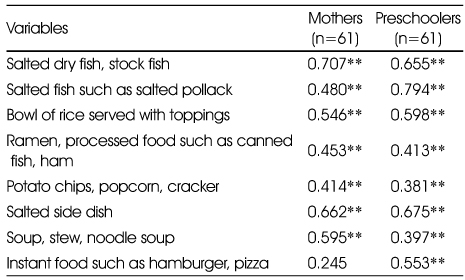Articles
- Page Path
- HOME > Korean J Community Nutr > Volume 20(1); 2015 > Article
-
Research Article
- Sodium-related Eating Behaviors of Parents and Its Relationship to Eating Behaviors of Their Preschool Children
- Ye Seul Kim, Hong Mie Lee, Jung Hee Kim
-
Korean Journal of Community Nutrition 2015;20(1):11-20.
DOI: https://doi.org/10.5720/kjcn.2015.20.1.11
Published online: February 28, 2015
1Department of Food and Nutrition, Seoul Women's University, Seoul, Korea.
2Department of Food Science and Nutrition, Daejin University, Pocheon, Korea.
- Corresponding author: Jung Hee Kim. Department of Food and Nutrition, College of Natural Sciences, Seoul Women's University, 623 Hwarangno, Nowon-gu, Seoul 139-774, Korea. Tel: (02) 970-5646, Fax: (02) 976-4049, jheekim@swu.ac.kr
Copyright © 2015 The Korean Society of Community Nutrition
This is an Open-Access article distributed under the terms of the Creative Commons Attribution Non-Commercial License (http://creativecommons.org/licenses/by-nc/3.0/) which permits unrestricted non-commercial use, distribution, and reproduction in any medium, provided the original work is properly cited.
- 1,148 Views
- 2 Download
- 6 Crossref
Figure & Data
REFERENCES
Citations

- Changes in the importance and performance of low-sodium management among childcare center cooks in Yongin, South Korea, after salinometer support programs: a descriptive study
Jiwoo Min, Youngmi Lee, Yunhee Chang, Yujin Lee
Korean Journal of Community Nutrition.2024; 29(4): 304. CrossRef - Evaluation of dietary behaviors of preschool children in Seoul and Gyeonggi-do associated with the level of parents' health consciousness: using nutrition quotient for preschoolers (NQ-P)
Soo-Youn Kim, Sung-Mi Cha
Nutrition Research and Practice.2021; 15(2): 248. CrossRef - Evaluation of dietary behavior and investigation of the affecting factors among preschoolers in Busan and Gyeongnam area using nutrition quotient for preschoolers (NQ-P)
Soo-Youn Kim, Sung-Mi Cha
Journal of Nutrition and Health.2020; 53(6): 596. CrossRef - School Dietitian Awareness, Practice, and Sodium Reduction Plan in School Meal Service
Eun Kyung Kim, Hae Young Kim
Korean Journal of Food & Cookery Science.2016; 32(2): 222. CrossRef - Physical Activity Assessment of Preschool Children Using Accelerometer - Including Comparison of Reintegrating Counts of Different Epoch Lengths -
Ji-Yeon Kim, Yeon-Jung Choi, Mun-Jeong Ju, Eun-Kyung Kim
Journal of the Korean Dietetic Association.2016; 22(3): 214. CrossRef - A Comparison of Salty Taste Assessment, Dietary Attitude and Dietary Behavior among Adult and Senior Women by Region and by Age in Korea
Lin Jiang, Yun-Young Jung, Hyung-Sook Kim, Gi-Seon Nam, Jin-Sook Yun, Jong-Wook Kim, Yeon-Kyung Lee
Korean Journal of Community Nutrition.2015; 20(2): 109. CrossRef
General characteristics of the study subjects
Perception of salty taste by mothers
1) Scored 1 to 5 points (Bland=1, slightly bland=2, Neither bland nor salty=3, slightly salty=4, Salty=5)
2) Mean±SD
Comparison of eating behavior between mothers and their preschoolers
1) N (%)
*: p < 0.05, **: p < 0.01, ***: p < 0.001 significantly different between mothers and preschoolers, respectively by χ2-test
Comparison of eating behavior score between mothers and their preschoolers
1) Mean±SD
**: p < 0.01, ***: p < 0.001 significantly different between mothers and preschoolers, respectively, by paired t-test
Comparison of preference on salty foods between mothers and their preschoolers
1) Scored 1 to 3 points (Dislike=1, Normal=2, Like=3)
2) Mean±SD
*: p < 0.05, **: p < 0.01, ***: p < 0.001 significantly different between mothers and their preschoolers, respectively by paired t-test
Comparison of consumption frequency of salty foods between mothers and their preschoolers
1) Scored 1 to 3 points (Don't eat frequently=1, Normal=2, Eat frequently=3)
2) Mean±SD
**: p < 0.01, ***: p < 0.001 significantly different between mothers and their preschoolers, respectively by paired t-test
Correlation between preference and consumption frequency on salty foods
**: p <0.01 by Pearson's correlation analysis
Comparison of dietary behavior related to eating soup, stew, ramen, and snacks
1) N (%)
2) Plural response
***: p < 0.001 significantly different between mothers and preschoolers by χ2-test
1) Scored 1 to 5 points (Bland=1, slightly bland=2, Neither bland nor salty=3, slightly salty=4, Salty=5)
2) Mean±SD
1) N (%) *: p < 0.05, **: p < 0.01, ***: p < 0.001 significantly different between mothers and preschoolers, respectively by χ2-test
1) Mean±SD **: p < 0.01, ***: p < 0.001 significantly different between mothers and preschoolers, respectively, by paired t-test
1) Scored 1 to 3 points (Dislike=1, Normal=2, Like=3) 2) Mean±SD *: p < 0.05, **: p < 0.01, ***: p < 0.001 significantly different between mothers and their preschoolers, respectively by paired t-test
1) Scored 1 to 3 points (Don't eat frequently=1, Normal=2, Eat frequently=3) 2) Mean±SD **: p < 0.01, ***: p < 0.001 significantly different between mothers and their preschoolers, respectively by paired t-test
**: p <0.01 by Pearson's correlation analysis
1) N (%) 2) Plural response ***: p < 0.001 significantly different between mothers and preschoolers by χ2-test

 KSCN
KSCN








 Cite
Cite


